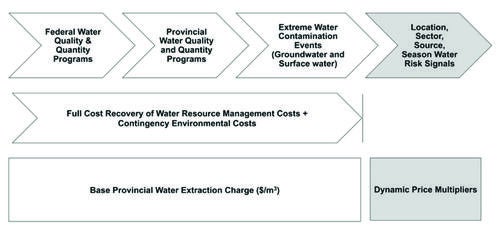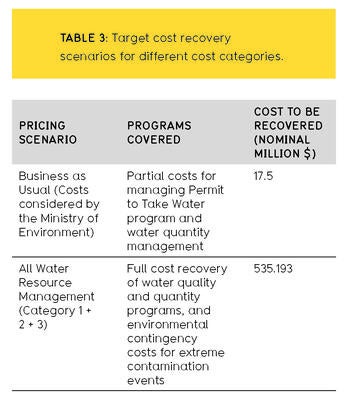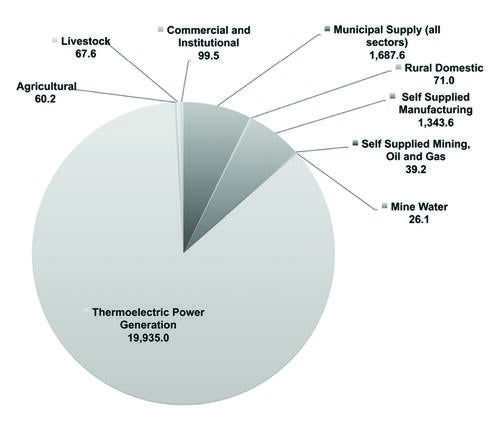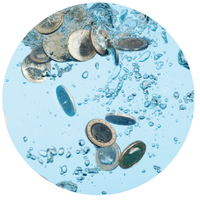Introduction
Given increasing anthropogenic pressures and climatic uncertainty on water resources, the use of effective demand management strategies will be critical for sustainable water management. In 2016, the Province of Ontario, Canada initiated a review to identify policy options to protect and manage groundwater and surface water resources in the longer term. At the same time, the Province imposed a moratorium on new or expanded groundwater extraction permits, currently extended until 1 October 2020, and increased the charge for water extracted under current permits from $3.71 to $503.71 per million litres, for the commercial water bottling sector.
Economic theory suggests that pricing a resource by appropriately reflecting its scarcity can incentivize optimal consumption. While Ontario prices extraction of surface water and groundwater resources, the level of the charges is not linked to the actual costs of water management or water quantity or quality risks. This research makes a methodological contribution by developing a flexible tool to calculate dynamic water extraction charges based on the full recovery of economic costs, such that jurisdictions do not have to be reliant on general taxes to finance water management initiatives.
Methodology
A pricing framework was conceptualized and applied to Ontario based on the principle of full cost recovery of water resource management and protection costs (Figure 1). Three databases were designed and built to operationalize the framework based on data from the Great Lakes-St. Lawrence-Ottawa drainage basin:

FIGURE 1: Conceptual bulk water pricing framework for Ontario.
- Water resource management cost accounting: a database of expenditures, including operating and capital expenses, as well as grants issued to agencies, for water management initiatives undertaken from 2007 until 2017 by various federal and provincial agencies. These costs, reported in nominal Canadian dollars, were averaged over specific time periods to calculate an annual cost of water resource management.
- Water withdrawal by sectors: database on the volume of water withdrawn by self-supplied water extractive sectors from Statistics Canada water use surveys.
- Sub-watershed, source and sector-specific risk multipliers: a database of “high”, “medium”, and “low” water quantity risk sub-watersheds based on conservation authority approved “Source Water Protection Technical Assessment Reports”. Multipliers were used to scale charges relative to water quantity risk categories. Similarly, water consumption-based sector multipliers, source type (higher-quality groundwater), and seasonal peak surcharge factors and multipliers were used (Table 1).

Using various equations and user-specified inputs, such as liable sectors, programs, sub- watershed location, use sector, and extraction volume, duration, type of source (surface water or groundwater) and seasonal factors, the tool calculates resulting water extraction charges.
Outcomes
Three main categories of water management costs emerge from the compilation of federal and provincial expenditures (Table 2).

The average federal and provincial costs for water resource management, including costs associated with categories 1, 2 and 3 (Table 2), are calculated to be $535.193 million per year. This is significantly higher than the $17.5 million per year that the Province currently attributes to water quantity management (Table 3).

The three sectors that use the most water in the Great Lakes-St. Lawrence-Ottawa basin are thermoelectric power generation, municipal water supply, and manufacturing. Municipal water supply includes both residential as well as industrial and commercial sectors connected to municipal systems supplying treated drinking water. The average annual volume of water withdrawn by all sectors is shown in Figure 2. The average annual volume withdrawn for all sectors that require water taking permits is calculated to be approximately 23,191 million m3/year. Using the average volume of water intake by these self-supplied sectors, the base provincial charge to recover all water resource management and extreme contamination events is approximately $23 per million litres.

FIGURE 2: Average annual volume of water withdrawn by sector in million m3/year in the Great Lakes-St. Lawrence-Ottawa drainage basin from 2007 to 2017.
About 86 per cent of the total volume of water use in Ontario is attributable to the thermal power generation sector. The Province, however, considers the thermal power generation sector to be a low consumptive user of water since the majority of the water it extracts is returned to the watershed, and currently exempts it from paying extraction charges. The sector does, however, benefit from water quantity and quality programs making the exemption debatable from sustainability and equity perspectives. The exemption for the thermal power generation sector is estimated to increase water extraction charges for other sectors about seven-fold.
Conclusions
The Province of Ontario, Canada has identified the need for a more long-term, comprehensive policy approach to managing its water resources. In response, it has placed a moratorium on new or expanded groundwater extraction permits and has raised extraction charges, for the water bottling sector. The charges, however, do not reflect full cost pricing, or current and future water security risks for surface water and groundwater users.
This study developed a flexible and dynamic bulk water extraction calculator based on data from the Province of Ontario taking into account cost and risk factors. The study estimates that the provincial water extraction base charge for all permit liable sectors is $23.08 per million litres, and notes that this rate will be significantly inflated if Ontario’s thermopower generation sector is exempted from these charges.
This study and tool will have a broad appeal to water policy and economics practitioners and scholars in Ontario and beyond interested in operationalizing the principles of water pricing based on full cost recovery and different water risk categories. Although the charges designed in this research are not reflective of full social, environmental and opportunity costs of optimal resource allocation, they are a necessary first step in calculating optimal water resource pricing.
Contact
 Michael Wood, School of Environment, Enterprise and Development
Michael Wood, School of Environment, Enterprise and Development
 Guneet Sandhu, School of Environment, Enterprise and Development
Guneet Sandhu, School of Environment, Enterprise and Development

Sandhu, G., Wood, M.O., Rus, H.A., & Weber O. (2019). Bulk water extraction charge calculator: a tool for sustainable water management in Ontario. Canadian Water Resources Journal, 45(1). doi:10.1080/07011784.2019.1685909
For more information about WaterResearch, contact Julie Grant.









